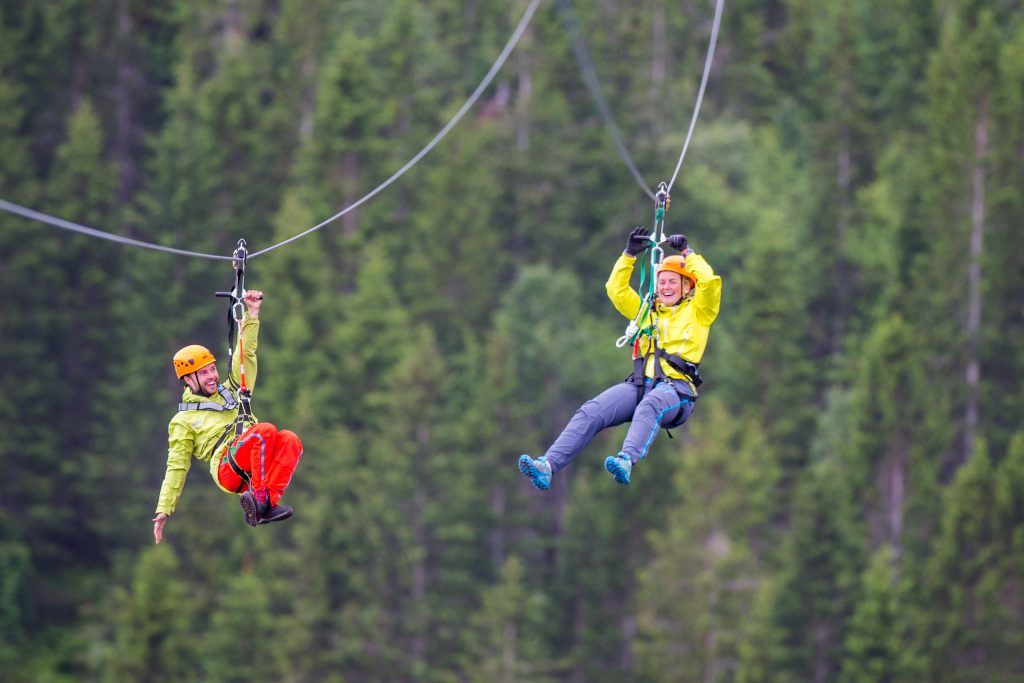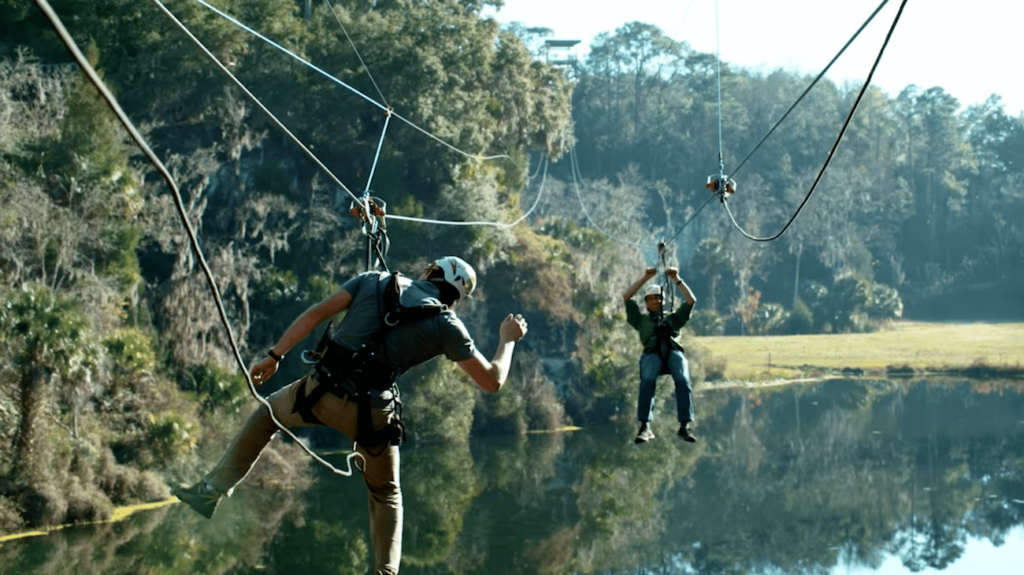Modern zipline courses have come a long way in recent years. With customers clamoring for ever-longer and faster rides, zipline operators have turned what was once a simple formula – a platform, a cable, a ladder for retrieving dangling riders – into a carefully calculated engineering achievement. In fact, if you are just starting out, we highly recommend hiring a zipline installation company that specializes in designing and building modern zipline courses.
View: Preferred Zipline Installer List
When designing a new zipline, a trained zip line installer will account for a variety of elements, including the angle and length of the cable, the weight range of the riders, the impact of the ball bearings in the zipline trolleys, and the arrival speed of different people and different trolley types as they come into the platform.
To make things more complicated, nearly all zipline tours take place outdoors, which means that installers also must adjust their calculations based on potential weather conditions. If there’s a headwind, will lighter riders reach the platform or get stuck and require a lengthy rescue operation? Conversely, if there’s a tailwind, will heavier riders overshoot the landing platform, potentially damaging themselves, their guides, or the zip line itself?
These are all safety essentials that professional zip line operators should factor into their initial calculations. Other aspects such as part durability, weather-resistance, wear over time, and maintenance requirements also play significant roles when choosing what to include in your zip line course.
Of course, with every zipline course there are also financial considerations to take into account. As is often the case in the adventure industry, these considerations extend beyond the core financials to the limitations of physical equipment that you are relying upon to provide that experience. Without the right equipment, you can’t provide a high-quality product.
Over the span of a multi-line zipline course, even subtle shifts in throughput can make a dramatic impact on the overall user experience.
For example, the original gravity braking system that was predominant in the early days of ziplining has largely gone extinct in commercial applications. Why? When using a U-shaped line with a gravity braking system, some riders will not reach the exit platform, resulting in major delays. Even though the materials to build such a line were relatively cheap and accessible, the retrieval process for rescuing so many stranded riders not only cost the guides a great deal of time and effort, but also prevented other riders from being able to access the zipline.
In other words, the throughput was so terrible that it hampered the financial viability of this style of zipline. Obviously, that’s an extreme example. Professional zipline courses are far more sophisticated these days; however, over the span of a multi-line zipline course, even subtle shifts in throughput can make a dramatic impact on the overall user experience, as well as the number of customers that a busy zipline course can potentially serve on a daily basis.
Modern Trends in Commercial Ziplining
If the old style of ziplining has been left behind for its safety and commercial shortcomings, what new trends do we see in successful modern zipline courses?

Focus On Throughput
Throughput may sound like a corporate buzzword, but increasing your throughput can dramatically improve other elements of your zip line business as well, beyond just the basic calculation of dollars and cents.
From a user experience standpoint, maximizing throughput means less time waiting and more time doing what they want to be doing: zip lining. By improving your throughout, you can effectively kill two birds with one stone. Your customers will have a better experience AND you, the operator, will make more money.
And that’s just the tip of the iceberg. In an industry where marketing largely consists of word-of-mouth and customer reviews, any improvement that you can make to your user experience also serves as a potential source of marketing, driving both return customers and attracting new ones. In this way, throughput is a gift that keeps on giving.
Of course, we’re not trying to downplay the obvious financial incentives of maximizing your throughput, either. It’s no secret that zip line equipment and upkeep costs can be high and user safety is often dependent on training and retaining qualified staff. While you can’t always control the fixed costs involved with running a commercial zip line course, one of the variables that you can control is how efficiently your customers move through your course.
By limiting unnecessary delays and incidents from the equation, you can serve more customers, while also providing higher customer satisfaction and lowering risk and potential liability.
More linked or sequential lines in each tour
Despite the long history of zip lining as a means of transportation, zip lining for fun is a surprisingly novel activity. In fact, the first recreational zip line course did not open until 1995. Since then, the industry has exploded. With so many options now available for customers to choose from, zip line courses are going to greater lengths (literally) to build attractions that stand out above the crowd.
As a result, there has been a remarkable increase in the amount of planning, design, and creativity that goes into building a modern commercial zip line course. Zip line installers specialize in meeting these demands and often undergo additional trainings to stay current in a rapidly evolving industry.
Many of the complexities in modern zip lining come from the demand for a wider variation of zip line lengths and arrival speeds, often occurring within a single course. A poorly designed zip line course has a distinctly repetitive feeling. The course might be fun for a while, but riders don’t want to feel like they’re doing the same thing over and over again.
Building variety into a zip line course makes for a superior user experience, but it also comes with its share of difficulties.
When there is a strong head wind or you have lighter riders, guides must exercise a significant amount of situational awareness and problem solving to make sure everyone in their group reaches the finishing platform. If you want to talk about a way to instantly ruin your throughput for the day, it doesn’t get much worse than having to send a guide out onto the line to rescue a stranded rider (not to mention the safety considerations that go along with this).
On the other hand, when dealing with a faster line, a tail wind, or an active braking system like handbraking which requires users to manage their own arrival speed as they approach the platform (a risky proposition, just ask anyone who has spent time working as a zip line guide), there is always a danger of riders overshooting the landing zone and injuring themselves or the unlucky guide who is tasked with manually operating the backup brake.
In short, an impressive zip line course design may be required to compete and attract customers in an increasingly crowded marketplace, but it also opens the door to a wider variety of potential things that can go wrong.
Increased attention to safety
As zip lining has become more popular, industry safety practices have also come under a higher level of scrutiny. It should come as no surprise that the majority of incidents happen during the braking process.
What is a Zip Line Brake System?
The Association for Challenge Course Technology (ACCT) and the American Society for Testing and Materials (ASTM) both have standards that apply to zip lines and the braking systems of zip lines. An EAD, also called an emergency brake, is mandated by ACCT standards in certain scenarios and ASTM requirements state that braking systems within a zip line must be fail-safe. Furthermore, most insurance companies require operators to follow ACCT guidelines in order to maintain their coverage.
ACCT Standards state that a zip line brake system should be designed to address:
“The level of risk to the participant posed by the failure of the brake system or any of its components, including potential for pinching, binding, entanglement, etc.”
The standards further state that “a qualified person” shall test the “brake system operational characteristics at the extremes of the design continuum for participant weight and arrival speed.” As an added safety precaution, we also recommend conducting an initial unmanned trial run to ensure that everything is working as expected, before fulfilling the ACCT testing requirements.
For a more in-depth explanation of zip line braking standards, read our white paper: Zip Line Braking Dynamics
When designing a modern zip line course, there are four major braking technologies to choose from:
- Active aka hand braking
- Gravity
- Magnetic
- Spring or impact braking
The ideal zip line leaves the control of braking to the brake itself. In other words, the process is automated and neither the riders nor the guides participate in the braking process. This is also known as a ‘passive’ braking system, as opposed to the common hand braking system where the riders wear gloves and actively press against the cable in order to slow their approach.
In an ideal situation, the braking process is not the only element that is automated. After an initial rider exits the platform, the brake should also automatically reset into position, only requiring a visual confirmation from the guide, before the next rider begins their run.
The most effective and least error-prone way to arrest zip line riders at the end of your course is to employ an automated brake system. Automated brake devices don’t eliminate the need for staff, but they do significantly reduce the potential for rider error.
By implementing an automated zip line brake, your guides can focus on improving the overall user experience, rather than constantly worrying about unsafe arrival speeds and whether or not the riders will follow their instructions.
For a full breakdown of the differences between active and passive zipline braking systems, check out our Zipline Braking Methods.




Leave a Reply